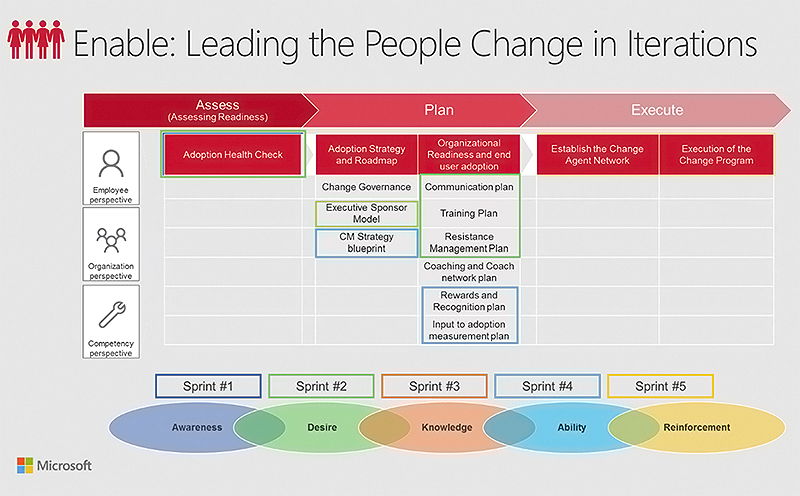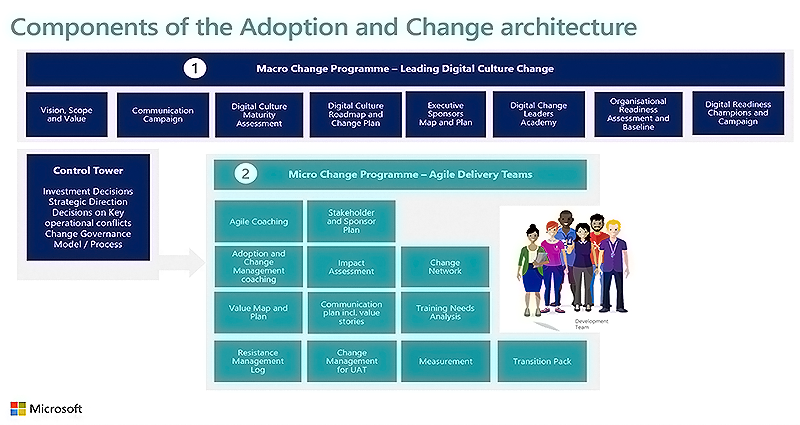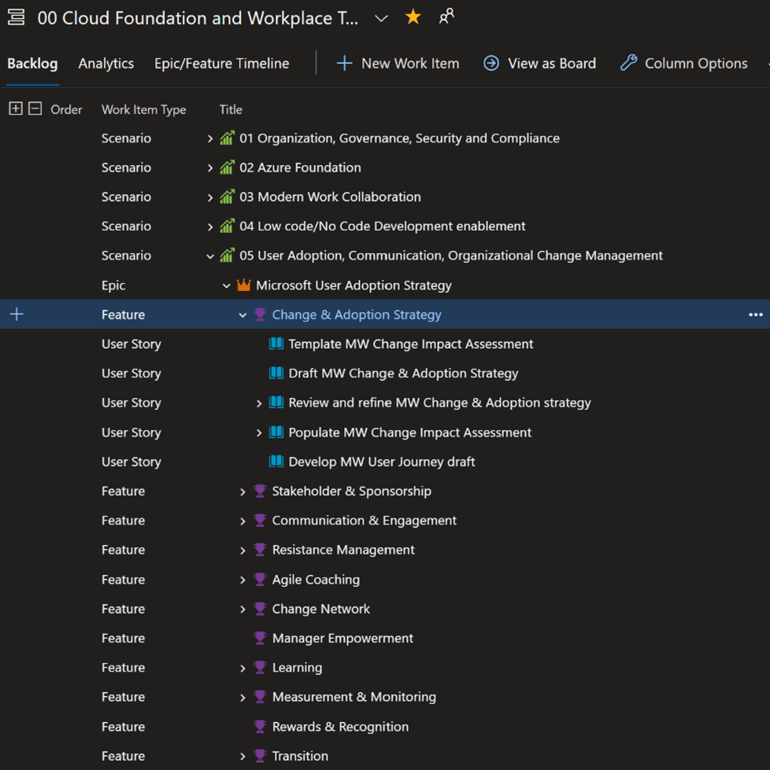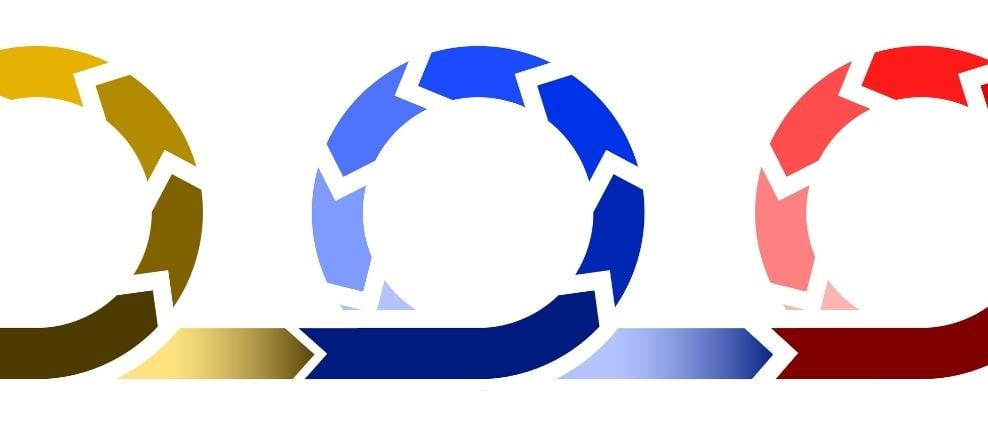The intersection of Agile solution development and change management is a global trend that is accelerating due to the pandemic and the need for digital transformation to prepare businesses for the future. Across Microsoft and the IT industry in general, project managers are increasingly applying Agile principles to technology projects. In fact, I would estimate that 80% of my customer implementation projects today are Agile based. At the same time, change practitioners are shaping the new standard for how to manage the people side of change iteratively. As part of our strategic partnership, Microsoft and Prosci have the ambition to set a benchmark.

At Microsoft and Prosci, we generally think of “Agile” change management as the application of change management principles that align with Agile, Scrum, SaFe or other iterative project management approaches, where work is released cyclically in incremental sprints instead of linearly in sequential milestones. In addition to being iterative, Agile change management emphasizes continuous improvement and adaptation throughout the project lifecycle. Until a few years ago, waterfall was considered the standard project management approach. However, change practitioners are observing a steep increase of projects that follow Agile working principles. Scrum or similar Agile methods are now the norm for IT projects.
And while we see a clear increase in demand for specialized change management experts, Microsoft and Prosci clients alike acknowledge that change management is a competency that should be developed in key roles that define a change and transformation program’s success. To accomplish this, change practitioners work with product owners, product development managers, Scrum Masters, Agile coaches, chief information officers, chief digital officers, chief innovation officers, and others who commonly apply iterative approaches.
Within Microsoft, the Adoption and Change Management team was established to meet demand from customer projects. It started in 2006 when dedicated change management experts, or “business strategy consultants,” were formally assigned to customer engagements to increase adoption of Microsoft services and tools. Over time, the team has evolved into the global Adoption and Change Management practice comprising about 100 Prosci Certified Change Practitioners with focused expertise in Microsoft technology-driven change and digital transformation.
Microsoft’s Adoption and Change Management team frequently works with clients who are deploying Microsoft enterprise technologies, including Azure, Microsoft 365, Dynamics 365, Power Platform, data analytics and artificial intelligence, and industry-specific solutions that are tailored to specific business needs. We tend to apply Agile change management in three ways:
In this scenario, we integrate change management with an Agile project (e.g., applying Scrum or SaFe). Although the project management team is applying an Agile framework, the change management team operates within conventional, waterfall-style phases of prepare, plan, and manage the change. The change team pulls necessary inputs or outputs from the development teams and turns around change strategies, tactics and artefacts that support enabling people to move through their ADKAR transitions. In other words, the change team is involved in project activities in the more classic way, such as with pilots or user acceptance testing.
For example, a leading material handling company in Europe developed a modern application to help service technicians in their daily work maintaining or repairing equipment at their customer sites. Because the solution was a considerable change to the way people worked, the organization wanted to deploy a structured approach to managing change. The Microsoft Adoption and Change Management team worked with the internal implementation team to establish a common framework and change capability leveraging the Prosci Methodology. While the project was set up to follow Agile principles, the change team successfully applied a waterfall approach within the assess, plan and execute phases.
 Material handling client’s change program in phases and aligned to sprints
Material handling client’s change program in phases and aligned to sprints
In this arrangement, the change team is part of the development team, often across numerous Scrum Teams (a cohesive group of professionals working toward the product or project goal), depending on the project structure. Change managers are involved end-to-end from the ideation phase to the release of production-ready minimum viable products (MVPs).
Apart from managing the people-side impacts of the change on roles or users, the change team’s mission is to take the entire organization across all levels on a cultural and mindset transformation that makes the project into business as usual. Typically, change managers’ conventional activities and responsibilities are expanded by Agile coaching, product owner readiness, upskilling of IT and business in Design Thinking, DevOps, Scrum, SaFe or specific tools such as Microsoft Azure DevOps, Kanban Boards or similar.
To illustrate this approach, consider a manufacturing client in renewable energy, which embarked on a digital transformation in 2019 with the ambition to become the digital leader in their industry. In addition to ensuring that their digital solutions solved real business problems, the client needed to involve the business from start to finish and ensure that colleagues were equipped and supported through the change journey.
In this case, business representatives became Product Owners, who got involved with ideation and discovery of use cases. The Scrum teams then developed production-ready MVPs within a time span of months rather than years. The people-side impacts included new Agile ways of working, culture and new mindsets, and adoption of the solutions.
To help the client succeed, the Microsoft Adoption and Change Management Team also supported their mission to establish an internal Digital Enablement Office. This effort involved Agile coaching, supporting user adoption of the new Microsoft solutions, and more. Due to the scope, the change team was fully integrated in the Scrum Teams.
 Renewable energy client's Agile change program architecture
Renewable energy client's Agile change program architecture
This last scenario involves organizations with very bold ambitions, such as the strategic goal to modernize and digitize their business operations to unlock competitive advantages or drive innovation. The IT organizations within these businesses want a product-centered mode of operations that maximizes the business value of IT solutions and services. Former startups like Spotify have demonstrated the value and impact of a human-centered approach to product engineering and development at hyper-Agile scale. An increasing number of organizations dip their toes into this concept but apply scaled Agile for enterprises.
Consider a car manufacturer that wants to establish an entirely new cloud-native and state-of-the-art IT platform and organization that applies Agile and DevOps principles. A multi-year program, the project paves the way for their future-state, cloud-first platform and IT target operating model. The challenge is that many people in the organization come from the legacy structure that ran their platform, systems and applications on-premises and with the classic separation of IT operations, development and support. Establishing DevOps and Agile ways of working will generate drastic people-side impacts.
Because the organization has a low level of change maturity and lack of change capabilities, the goal is to manage changes due to new roles created by the new structure as well as leading the change in behaviors, mindset and culture for the organization as a whole. In this future state, the business and IT partner are much closer together in developing digital products and solutions that address major business problems or serve as new business models. The IT matures from being a commodity service toward becoming a true enabler for the business strategy. 
Manufacturing client's adoption and change management backlog in Azure DevOps
When planning Agile-based changes with Microsoft clients, I choose the best scenario based on circumstances, including project setup, client preferences, their established methodologies and practices, existing capabilities, and their experience. Once in the field, my teams and I tend to incubate an initial approach, adjusting and adapting as soon and fast as possible (i.e., fail fast, learn and adapt fast) to establish a routine and rituals early in the process.
If you have not been exposed to Agile scenarios yet, and you’re ready to embark on your own personal change journey, you might wonder how to get started. Before you get serious about it, remember that there is still strong value and demand for classic change management in non-Agile project scenarios. The critical question to ask yourself is, does your organization have the need to keep pace with complex digital and cloud-based innovations and the accelerated changes in market conditions that go along with them? If so, adopting Agile change management approaches will be a great move for you and your organization.



 Renewable energy client's Agile change program architecture
Renewable energy client's Agile change program architecture 






